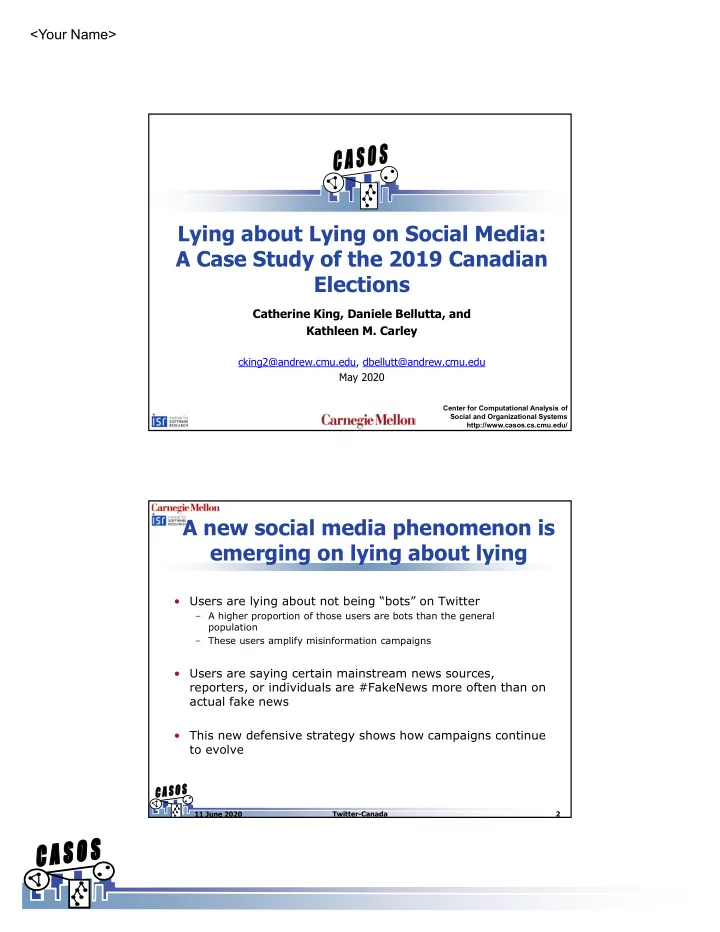

<Your Name> Lying about Lying on Social Media: A Case Study of the 2019 Canadian Elections Catherine King, Daniele Bellutta, and Kathleen M. Carley cking2@andrew.cmu.edu, dbellutt@andrew.cmu.edu May 2020 Center for Computational Analysis of Social and Organizational Systems http://www.casos.cs.cmu.edu/ A new social media phenomenon is emerging on lying about lying • Users are lying about not being “bots” on Twitter – A higher proportion of those users are bots than the general population – These users amplify misinformation campaigns • Users are saying certain mainstream news sources, reporters, or individuals are #FakeNews more often than on actual fake news • This new defensive strategy shows how campaigns continue to evolve 11 June 2020 Twitter-Canada 2 1
<Your Name> Why should we care? • There’s widespread concern since 2016 that foreign actors are trying to increase division and spread misinformation in democratic nations 11 June 2020 Twitter-Canada 3 2019 Canadian Federal Election The election was held in October This was a referendum on Prime 2019 to elect members of Minister Trudeau and his Liberal Party Parliament The #TrudeauMustGo twitter Journalists suspected that movement was amplified by bots #NotABot was used disingenuously and often paired with #NotABot The “fake news” phrase has been This term is used by both used to discredit true news malicious actors and regular people stories and political opponents 11 June 2020 Twitter-Canada 4 2
<Your Name> 11 June 2020 Twitter-Canada 5 Twitter data related to the election was collected • Collected streaming tweets matching a set of search terms – July 2019 through November 2019 – Yielded 16+ million tweets written by 1.3+ million users using over 137,000 hashtags 11 June 2020 Twitter-Canada 6 3
<Your Name> Two groups of hashtags were identified for further study 11 June 2020 Twitter-Canada 7 The data was augmented with bot identification • Tier 1 BotHunter algorithm developed by Beskow and Carley determines the probability that an account was run by a bot • The algorithm considers: – Screen name length – Number of tweets – Number of friends and followers – Content of a tweet – General timing of tweets • Likely organizational accounts were removed • We use a probability threshold ranging from 0.6 to 0.8 throughout 11 June 2020 Twitter-Canada 8 4
<Your Name> The likely targets of the #FakeNews were determined • For each tweet, the set of targets was the union of: – The users mentioned in the tweet – The author of the original tweet if the tweet is a reply – The websites linked to in the tweet (if they belong to a potential target) – The specific targets of fake-news hashtags (ex: #fakenewscbc is likely targeting the Canadian Broadcasting Corporation) • Potential targets included political organizations, news, politicians, and reporters 11 June 2020 Twitter-Canada 9 The most targeted are mainstream news agencies and politicians 11 June 2020 Twitter-Canada 10 5
<Your Name> Users of both hashtags separate into two partisan groups 11 June 2020 Twitter-Canada 11 Users of both hashtags separate into two partisan groups 11 June 2020 Twitter-Canada 12 6
<Your Name> Users of #NotABot are more likely to be bots than non-users 11 June 2020 Twitter-Canada 13 Users of #NotABot are more likely to be bots than non-users • We ran a Mann-Whitney U Test to test if the distribution of two populations is the same, which was also highly significant 11 June 2020 Twitter-Canada 14 7
<Your Name> Users of #NotABot are more likely to be bots than non-users • The difference in the mean and median bot scores for the two groups is ~2%, with the #NotABot users more likely to have higher bot scores 11 June 2020 Twitter-Canada 15 Discussion • Large and established news agencies are the most targeted with accusations of spreading #FakeNews • Accusations calling something “fake” are coming from both liberal and conservative leaning users • Using not-a-bot hashtag is not a reliable signal for indicating that one is not a bot • Both networks of hashtag users show a strong partisan divide 11 June 2020 Twitter-Canada 16 8
<Your Name> Limitations • The Twitter sample may not be representative of the entire Twitter conversation surrounding the election • The method for determining fake news target is a reasonable heuristic but may not catch all targets • The Not-A-Bot analysis is based on probabilities rather than certainties that an account is a bot • These results may hold for other elections in similar countries, but circumstances or misinformation strategies may quickly evolve 11 June 2020 Twitter-Canada 17 Future Work • Build on this set of hashtags to investigate how lying about lying continues to evolve over time or in different countries • Examine these hashtags in non-political contexts • Investigate how much of an impact these hashtags are having on human behavior do other users believe them? 11 June 2020 Twitter-Canada 18 9
<Your Name> Conclusion • Our work describes new tactics being used to influence elections • Mainstream news organizations are being labeled as “fake news” at higher rates than fake or satirical sites • A Twitter user claiming to not be a bot was more likely to actually be a bot 11 June 2020 Twitter-Canada 19 Questions? Catherine King, Daniele Bellutta, and Kathleen M. Carley cking2@andrew.cmu.edu, dbellutt@andrew.cmu.edu 11 June 2020 Twitter-Canada 20 10
Recommend
More recommend